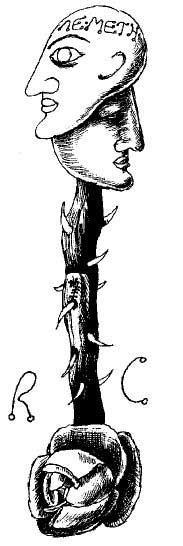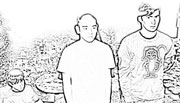PEOPLE DO ‘ZINES for all kinds of reasons. I’ve always done them first and foremost to preach about these three-minute shortcuts to nirvana that I’ve discovered: this amazing music that you absolutely have to hear. You may have heard of the fanzine I did from 1984 to 1995 called Chemical Imbalance. It was kind of a big deal at its peak (circulation 8,000), at least in the indie-rock world. C.I. expanded the definition of what a fanzine could be, covering punk rock, free jazz, comic art, art brut, and “transgressive” writing from its very first issue. (I didn’t know what the rules were in the first place, so I wasn’t aware until later that I’d broken them.)
I have always had an abundance of energy for things that I like and very little time for stuff I do not. This has made me a pain in the ass at most of my jobs and a poor student in calculus class, but a good fanzine editor and freelance writer. Unlike most of my slacker friends, I have no problem working day and night; it just has to be something I believe in. Not to sound too corny, but I have faith in the transformative powers of the cultural arts, if I believe in anything at all.
I would have made a rousing preacher, but my parents raised me without religious conviction. From an early age I fashioned my own belief that music is one of the most valid ways to commune with God (visual art, literature, and films also figure, but music is for me the most direct route). I may sound like a total freak, but you know that weird, low, funky bass line that starts the Bee Gees’ “Jive Talkin'”? That particular song fragment—which I listened to over and over again—provided strict evidence for the existence of a Supreme Something-or-other.
Chemical Imbalance was the first international publication to print stuff by or about humorist David Sedaris; musicians Girly Sound (Liz Phair), Galaxie 500, and Steve Fisk; filmmaker Sadie Benning; and artists Alex Ross, Chris Ware, and Jim Woodring. After the third issue, I saved money from working on a lawn crew in my then home of South Florida to include a 7-inch EP, a concept which stuck. I put out previously unreleased music from Pavement, Sonic Youth, Television Personalities, Yo La Tengo, Sun City Girls, Opal, Daniel Johnston, Beat Happening, Mekons, Kicking Giant, and the first new music by Faust in 15 years. It was really important to me that people hear these bands; at the time, no other ‘zine released real singles with every issue.
BUT I WAS JUST A KID then and not a very good writer to begin with. So I also printed bad poetry and the most embarrassingly pretentious, acid-addled record reviews in the history of embarrassing, acid-addled record reviewing. (The absolute worst was when I compared well-bred Boston indie-poppers Big Dipper to Raskolnikov, the tormented hero of Dostoyevsky’s Crime & Punishment.) Most of my readers were forgiving; those who were not (Lydia Lunch and Steve Albini among them) sent excellent hate mail.
In the limited “black bag” edition of Big Black’s infamous Headache record, underground guru/scribe Byron Coley wrote a short story in which a character named Mike McGonigal is birthed through the butt of the barber from Mayberry: “There’s an art fag sticking out of your keister.” This is, in retrospect, the highest compliment I have ever been paid. My agenda was far more gay-, art-, and women-friendly than the prevailing coolster ethos of the day.
I moved to New York City at the age of 18 to attend NYU. I worked weekends at See Hear, a dingy basement shop in the East Village that sold only fanzines and music books. Working there put me in touch with not only the entire mid-’80s ‘zine scene but the hippest musicians of the day and dozens of like-minded freaks who soon wrote, drew, and made music for C.I. The ‘zine went from describing existing bands and scenes to creating its own. I put together C.I.-sponsored rock shows with Galaxie 500, Go Team, Sonic Boom, and more; curated a group show in a gallery; and put together a video compilation for Atavistic. The amount of work was starting to wear on me, however, and I was unwilling to make the necessary changes to turn the magazine into my livelihood. It was an idealistic thing; I thought it would remain pure if removed from commerce, if it remained a crazy, obsessive hobby.
In June 1993, within months of releasing an issue that featured a skewered heart on the front cover (a color drawing by Raymond Pettibon), I was stabbed twice in the chest, mere millimeters from my own heart. It was a botched mugging in front of my Brooklyn apartment. After the open-heart and collapsed-lung surgeries, I freaked the fuck out and got heavily into drugs. I’d already been working on a drug habit, doing a bag or so of heroin a day. But after I lost my fear of needles in the hospital, it was less than a year before I sold all my stuff and was living on the streets. I hit bottom within a year and left New York for sunnier climes. I got clean for good on New Year’s Day ’95, did one final issue (the magazine’s name seeming more than prescient at this point), and concentrated on freelance writing.
My chops as a writer greatly improved, and after I was hired as a music editor at Amazon.com in 1998 and worked with world-class writers, my editing “skill set” got way better too. But I never lost the urge to control and sculpt my own little art universe, to curate a ‘zine of my own. I didn’t want anyone to tell me that a 7,500-word interview with some obscure experimental art-rock band is not exactly a good idea.
IN MY NEW MAGAZINE, Yeti, which has just hit the stands, I can ask the dumbest questions, like “What does playing music feel like?”; I can print an article about a person purely out of enthusiasm, regardless of whether there is some new product to consume or the artist is coming next week to the club down your block.
Coedited with longtime Seattleite Daniel Pirone, Yeti is not a mega-‘zine but a 228-page book with a CD in it (the first issue’s disc features Elliott Smith, Stereolab, Carissa’s Wierd, Nobukazu Takemura, Califone, S, John Atkins from 764-Hero, and the first release of Harry Smith’s musique concrete recordings). We chose this 6- by 9-inch book format out of delusions of longevity; those old newsprint ‘zines just don’t hold up over time. I also have fallen in love with small press literary journals from the ’60s, such as Locus Solus, Fuck You, A Journal of the Arts, and Caterpillar, as well as the edgy and affable contemporary lit magazine Open City. I wanted the new ‘zine to reference those, to be associated with them if only in such a superficial way as the format.
Fanzines as a whole have changed since the late ’70s; there is no need for dozens of pages of record reviews owing to the proliferation of subcultural news and information sites on the Web. Besides, The New York Times writes about every new Oval, Caetano Veloso, and Bright Eyes release or show, and they have knowledgeable writers too—so what could a ‘zine add, especially when the record in question will be three months old when the ‘zine hits the stands? Now that fanzines have been mostly removed from their positions as town criers for the scene and a Maximum Rock & Roll scene report seems nothing more than a quaint reminder of ye olde punke rocke days gone by, the nonvirtual ‘zines can get weirder and more interesting.
Of course, rampant weirdification has been happening in ‘zineland for some time now, as any reader of Beer Frame (“the journal of inconspicuous consumption,” which got its start as a proposed column for C.I.: the writer got tired of waiting for me to respond and did it himself), Bananafish (indecipherable writing about indecipherable music), Halana (from indie rock to drone-bliss compositional music), Rollerderby (Lisa Carver’s ‘zine was the ultimate personal freak scene as reflection upon the world at large), Hermenaut (readable theory-informed pop culture writing, what the Baffler could have become if it took itself less seriously), or Giant Robot (Asian pop culture) is well aware. They can take chances and make unexpected connections.
I’d like to think Chemical Imbalance had something to do with the movement of music-based ‘zines toward less coherent, more eccentric content, but they are each coming from really different places. That’s the joy of the fanzine, the totally idiosyncratic worldview that you won’t find anywhere else. If Yeti turns out to be half as good as any of the ‘zines I’ve mentioned, it all will be worth the back pain, carpal tunnel syndrome, and eye strain.
Issue number one of Yeti features photos of Olympia’s music scene by Tae Won Yu, an interview with Portland filmmaker/screenwriter Alan Greenberg, Seattle’s own Charles Krafft, and an obituary of former Seattle resident and Screamers frontman Tomata Du Plenty. Yeti is available at local record shops and Lipstick Traces.








